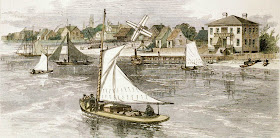 The
Seaside School (Gibbs House) of Johns Hopkins University colorized
sketch by Henry Osborne published in a special German edition of Frank Leslie's Illustrated Newspaper November 27, 1880
The
Seaside School (Gibbs House) of Johns Hopkins University colorized
sketch by Henry Osborne published in a special German edition of Frank Leslie's Illustrated Newspaper November 27, 1880
From Seasoned By Salt: A Historical Album of the Outer Banks by Rodney Barfield
 |
| Windmill at Beaufort circa 1890 Live Oak and Front Streets NC Archives and History |
Windmills dotted the landscape of coastal North Carolina from the eighteenth century until the twentieth. Eighteenth-century mills are documented at Nixonton in Pasquotank County (Old Windmill Point); Swansboro, Marshallberg and Beaufort in Carteret County; and on Portsmouth Island.
Swansboro historian Tucker Littleton made a survey of the state's windmills in the 1970s and documented 155 structures.
North Carolina windmills were of the 'post mill' type--framed rectangular sheds built atop a single post some twenty or thirty feet off the ground. The entire structure revolved on the post and was manipulated by a tail post that reached from the building to the ground some seventy feet away. A wheel attached at the ground end of the tail pole ran in a track. Thus, the mill could be positioned to catch the prevailing winds.
The rotation of the fans turned a huge assembly of wooden gears inside the structure, which in turn moved the stone that crushed the grain.
The speed of the four fans was controlled by sails that covered their surface. The sails were furled to accommodate wind velocity, in much the same way that sails are used on boats. Regulation of the fan revolutions was important to the quality of meal produced. Too much speed on the stones scorched the grain and ruined it.
Mills were used for grinding wheat and corn and for pumping water. The former type were primarily located north of Onslow County and the latter south of Pender County. The mills of New Hanover and Brunswick Counties were often employed in the production of salt.
Post mills were simple and straightforward structures that could be easily built from available material. If a location proved unprofitable, they were frequently loaded onto wagons and hauled to new sites.
Ironically, the greatest threat to coastal windmills was its source of power. Severe storms and hurricanes toppled many mills and lightning destroyed others. These testimonials to North Carolina's maritime heritage eventually became outdated derelicts made useless by the advent of electricity and gasoline engines, and one by one, they were destroyed."
John L. Stoddard, Scenic America
